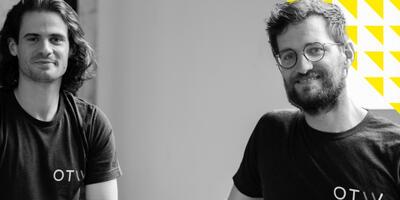
OTIV’s self-driving tech set to upgrade global rail transportation
OTIV is rapidly claiming its spot among major key players who have been dominating the international rail industry for decades. Increasing both the safety and efficiency of passenger and freight rail vehicles, the startup actively contributes to the shift from road to rail and thus to more sustainable mobility – all from its HQ in Ghent (Flanders). How they pull it off? Cofounder Sam De Smet explains.
In short
- The tech: from AI-based driver assistance solutions to remote-controlled and fully autonomous driving systems.
- The startup: founded by Sam De Smet and Niels Van Damme in 2020. Based in Ghent (Flanders), active in the EU and the US.
- The goal: lead the autonomous revolution in rail.
3 steps to OTIV’s go-to-market strategy
Although the rail industry covers an enormous market around the globe, it’s still a small world comprising just a few key players. Nevertheless, OTIV has expanded its activities into 9 countries in 3 years’ time. Strategically claiming its spot among industry giants, the startup takes a 3-step approach:
1. Start off with niche applications
Sam and his team first entered the market with high-performance sensors and custom algorithms for on-site rail logistics in industrial facilities.
“Large chemical corporations, steel factories and ports, for example, typically make use of on-site rail networks,” Sam says. “That’s the kind of customers we targeted first. From there, we started building other applications for different kinds of rail vehicles.”
2. Build trust for autonomous tech
By improving the safety and efficiency of its customers’ rail operations first, OTIV gradually instils a positive conviction toward autonomous transportation.
Sam: “First, we enable operators to leverage the potential of driver assistance systems in terms of safety, efficiency, and workforce allocation. In a next phase, we’ll be evolving toward fully self-driving technology.”
3. Nurture references
Operating in a rather small, close-knit business environment, OTIV notices that industry players often follow and trust each other’s partner experiences and referrals
Sam: “That’s why we deliberately try and bring in one hotshot name per market segment per target country: one big industrial player, one freight train operator, one light rail transit network, for example.”
Breaking traditions
That close-knit market, which is dominated by longstanding, giant corporations, is OTIV’s largest obstacle and opportunity at the same time. “There aren’t many startups active in the rail industry yet,” Sam explains. “We have to work hard on our credibility in order to lower the barriers and find a way in.”
“We don’t have the ambition to ever build trains ourselves – we’ll leave that to the pros – but we make them see that there are ample opportunities for innovation that bring along numerous benefits. That’s what our extensive expertise can provide – and we do it well.”
Having high-profile partners and customers like ArcelorMittal, Deutsche Bahn and SNCF Group surely adds to OTIV’s credibility. But how does a small-town startup with just 3 years of experience get to them?
Sam: “For every new market we enter, we rely on local representatives from Flanders Investment & Trade (FIT). They’ve managed to arrange introductions everywhere we’re operating now: from the Netherlands, Italy, and the UK, all the way to the US.”
With FIT’s help, OTIV attracts the attention of the greats through:
- market introductions
- trade shows and startup events
- successful capital rounds
Speaking of money …
Securing financing doesn’t come easy for OTIV. Sam says: “Because of our focus on the rail industry, we’re an outlier in the startup funding scene. Many investors are unfamiliar with the market and the opportunities that lie there.”
Despite these challenges, OTIV did already find funds from, among others:
- imec.istart, one of Europe’s leading tech startup accelerators offering pre-seed funding
- Pitchdrive, an early-stage VC from Antwerp, Flanders
- Finindus, an investment company funded by ArcelorMittal and the government of Flanders with industry 4.0 as one of its investment focal points
- SHIFT, a Dutch venture capital fund focusing on smart mobility investment, among others
Special recognition as International High Potential
Hosted by Flanders Investment & Trade (the government agency powering Startup.Flanders), the first-ever Flanders International Business Awards honored B4Plastics as one of three promising startups poised for international success. They were:
- tributed as International High Potential
- offered a support track for international growth, fully tailored to their ambitions
Sam: “We’re delighted with this fine recognition. It’s a pat on the back for our entire team that succeeds in leaving a mark in an industry that isn’t traditionally characterized by its innovational speed.”
The most important result OTIV wants out of the Startup.Flanders support track? “Access to international commercial and fundraising opportunities. Our market is global, and we have the ambition to become an international reference in what we do. This means forging new partnerships in unexplored geographies, as well as expanding our network to international VCs and other sources of capital."
Startup.Flanders, home for hungry startups
Joining Startup.Flanders means joining a community that brings you and your startup closer to destination tomorrow. We serve success for hungry startups just like yours. How exactly? Discover how we have your back – or drop us a line. We can’t wait to talk!



